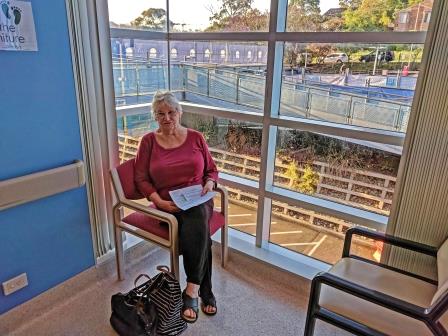< What did we learn from PROBE?
Older people with bleeding disorders often develop strategies to work around their physical problems and share them with each other and they had a similar constructive approach to suggesting solutions for the needs assessment. HTCs also took the opportunity to explain the issues they had been managing and discuss their ideas on what else would help.
Patient-centred care
An important underlying principle was to achieve ‘patient-centred care’. What will happen along the patient journey as the person with the bleeding disorder grows older? What services and help will they need? What will be the bumps along the way? What can be done to improve their experience – and their health and quality of life? What could help them to stay in the workforce longer?
Some suggestions were:

‘Having to treat less could help. Getting the half-life products might reduce having to treat from every 3 or 4 days, but with the sub-cutaneous product I could treat once a month. Accessing veins will become an issue the older you get, also with my elbow getting worse – and I think about getting dementia or something like that.’
‘I think access to therapies to keep strong and mobile. I am talking about my local community support centres, so I don’t have to go to the hospital to access my aqua-physio. Having access to parking spaces would help, so we don’t have to walk too far.’
‘Often a chronic illness such a bleeding disorder needs holistic care. Our current hospital and referral system is such that each specialisation acts as a silo rather than working together. This is fine if a person is treated for a one-off issue. But becomes a problem when an illness creates a myriad of issues that need examination.’
‘Lots of things [will help to keep working]. Flexibility of work hours, having an understanding/supportive employer, career advice, support to retrain if required, pain management, physio, counselling, psychosocial support, you name it.’
Hepatitis C and HIV
HFA also looked into the specific issues around hepatitis C and HIV in older community members. Nearly all who had been exposed to hepatitis C had been now been cured and were grateful for their successful treatment and the potential improvement to their health and lifespan. Although hepatitis C had a major impact on the working and personal lives of many, they often brushed it over and had tried to take it in their stride.
The needs assessment highlighted that there were still some medical issues with hepatitis C: the need for ongoing liver health monitoring for those with cirrhosis, and the unknown hepatitis C status of some people with mild conditions, including some women who carry the gene. There was also a small number of individuals whose treatment had been unsuccessful or could not have treatment and were living with advanced liver disease.
The consultation underlined the cumulative impact of living with a bleeding disorder on reducing income over a lifetime and increasing health care costs. Having hepatitis C or HIV added to this impact. Although vigorous exploration of government financial safety net options may help some older people with bleeding disorders financially, they will have out-of-pocket health and welfare costs not covered by existing programs. Most have been affected by hepatitis C. In 2004 the Senate Inquiry into Hepatitis C and the Blood Supply made recommendations to extend financial assistance and case management to this group which were never implemented. The report findings noted that providing this would make a considerable difference to managing the care and quality of life of older people with bleeding disorders affected by hepatitis C into the future and supported the need for HFA to pursue these recommendations further.

‘There are the added medical issues [of living with hep C] – the extra layer of appointments and medical management. Getting rid of hep C was a load off psychologically – one less thing to worry about. Also, my risk of liver cancer has dropped dramatically, which was a really happy thing. I have an ultrasound every six months for monitoring, surveillance for cancer. I am lucky to be here. And the treatment for hep C came along in time for me. So, it’s not so bad having an ultrasound every six months, when you are cured.’
‘It’s funny getting older with hep C. It didn’t affect me. I live quite happily. It happened years ago. I get the occasional liver scan. Slight anomalies, the next one will be clear. I didn’t know I had it until the 1990s, by which stage I was married and had children. And suddenly they say you know you have hep C. That kind of hit me with a ton of bricks – when, where? But you get your head around it and go on.’
‘Of course, all that trauma is still there. Most have been treated for hep C and doing well. But 20 to 30 years of their optimal life have been affected. They were not feeling great and only realised after they had [successful] treatment. The early treatments had severe side-effects and caused psychiatric disturbances, for example, one had severe depression and his marriage nearly broke down.’
Mental health and support
Mental health was identified as another important area. There was much discussion from both community members and HTCs about the need for professional psychosocial care (eg from a psychologist, counsellor, social worker or psychiatrist) and that it should be extended to the person’s partner and family as well, when required. However, there was also a big focus on how to support the older person to stay active mentally and socially, to do things that interest them, keep up with family and friends and contribute their skills and experience to the community.
In the Getting Older Community Survey most people said they found it helpful to keep up with other people in the bleeding disorders community. HTCs explained that peer support had a very important role in maintaining resilience. Older community members could share strategies that had worked for them and give each other confidence to take steps to try something different or to advocate for themselves. Friendships could make a big difference. This could be friendships with other people with bleeding disorders or with other people who shared the same interests, and getting older was seen as a time to seek out groups where friendships could be established.
COVID-19 has changed the way we socialise and many of us have tried out digital technologies like Skype and Zoom to keep up with friends and family. Most people who completed the Getting Older Survey said they preferred face-to-face events and only a third were interested in online support. However, after being exposed to these digital platforms recently, their attitudes may have shifted. Although face-to-face events are clearly the first choice as an opportunity to meet and get to know others, digital options for peer support may provide another way for older people with bleeding disorders to connect with each other when they are unable to meet face-to-face because of distance, mobility problems, or other reasons.
‘The ones I know are loving the Men’s Shed and creating things. One group I know of actually built aids for disabled. I know others who have projects like restoring furniture. Because men love to be doing stuff.’

‘It’s always better to sit around a table and chat. We have a men’s breakfast [in my local haemophilia foundation] and discuss how we manage with certain circumstances. That is something that is practical and relevant to me. People going through the same thing as you is reassuring – you can work it out when you are sitting down together and have a laugh about it.’
‘I have never met anyone in Australia who has my bleeding disorder. Hence, my only contact is with people overseas over social media.’
Haemophilia Foundation Australia acknowledges the Traditional Owners and Custodians of Country throughout Australia, the land, waters and community where we walk, live, meet and work. We pay our respects to Elders past and present and extend that respect to all Aboriginal and Torres Strait Islander peoples.
Sign up for the latest news, events and our free National Haemophilia magazine